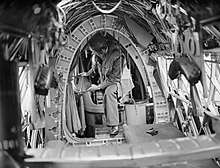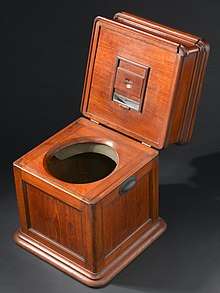Portable toilet
A portable or mobile toilet is any type of toilet that can be moved around, some by one person, some by mechanical equipment. Most types do not require any pre-existing services, such as sewerage disposal, but are completely self-contained.
.jpg)
They can be used in a variety of situations, for example in urban slums of developing countries, at festivals, for camping, or on boats. One well-known type of portable toilet is a chemical toilet but other types also exist, such as urine-diversion dehydration toilets, composting toilets, container-based toilets, bucket toilets, freezing toilets and incineration toilets.
A portable toilet is not connected to a hole in the ground (like a pit latrine), nor to a septic tank, nor is it plumbed into a municipal system leading to a sewage treatment plant; it can, by definition, be picked up and moved. Some portable toilets can be carried by one person, as in the main image, whereas others need heavy lifting equipment such as a truck and crane.
Types
Chemical toilets

A chemical toilet collects human excreta in a holding tank and uses chemicals to minimize the odors. These chemicals may either mask the odor or contain biocides that hinder odor-causing bacteria from multiplying, keeping the smell to a minimum.[1] Chemical toilets include those on plane and trains (although many of these are now vacuum toilets), as well as much simpler ones.
Portable camping toilets
.jpg)
A simpler type of portable toilet may be used in travel trailers (caravans, camper vans) and on small boats. They are also referred to as "cassette toilet" or "camping toilet", or under brand names that have become generic trademarks. The Oxford English Dictionary lists "Porta Potti" ("with arbitrary respelling") as "A proprietary name for: a portable chemical toilet, as used by campers", and gives mostly American examples from 1968. The OED gives this proprietary name a second meaning, "a small prefabricated unit containing a toilet, designed for easy transportation and temporary installation esp. outdoors", which Wikipedia covers under chemical toilet.
The other name common in British English is "Elsan", which dates back to 1925.[2] According to the Camping and Caravanning Club, "Today you will often see campsites refer to their Chemical Disposal Points as Elsan Disposal Points because of the history and popularity of the brand."[3] The Canal and River Trust uses both brand names, in lieu of any unbranded term.[4]
One colloquialism for these simple toilets is the "bucket and chuck it" system,[5][6] although in fact they no longer resemble an open bucket (see bucket toilet). These are designed to be emptied into sanitary stations connected to the regular sewage system. These toilets are not to be confused with the types that are plumbed in to the vehicle and need to be pumped out at holding tank dump stations.
Urine-diversion dehydration toilets
Portable urine-diversion dehydration toilets are self-contained dry toilets, sometimes referred to as mobile or stand-alone units. They are identifiable by their one-piece molded plastic shells or, in the case of DIY versions, simple plywood box construction. Most users of self-contained UDDTs rely upon a post-treatment process to ensure pathogen reduction. This post-treatment may consist of long-term storage or addition to an existing or purpose-built compost pile or some combination thereof. A post-treatment step is unnecessary in the case of very modest seasonal use.
Others
- Bucket toilet
- Freezing toilet
- Incineration toilets
- Composting toilet
- Container-based toilet
- A commode chair (a chair enclosing a chamber pot) is a basic portable toilet that was used for example in 19th century Europe
History

The close stool, built as an article of furniture, is one of the earliest forms of portable toilet. They can still be seen in historic house museums such as Sir George-Étienne Cartier National Historic Site in Old Montreal, Canada. The velvet upholstered close stool used by William III is on display at Hampton Court Palace; see Groom of the Stool.
Early versions of the "Elsan chemical closet" ("closet" meaning a small room, see water closet, WC, and earth closet) were sold at Army & Navy Stores. Their use in World War II bomber aircraft[7] is described at some length by the Bomber Command Museum of Canada; in brief, they were not popular with either the flying crew or the ground crew.[8]
African-Americans living under Jim Crow laws (i.e. before the Civil Rights Act of 1964) faced dangerous challenges. Public toilets were segregated by race, and many restaurants and gas stations refused to serve black people, so some travellers carried a portable toilet in the trunk of their car.[9]
Society and culture

A slang term, now dated or historic, is a "thunder-box" (Oxford English Dictionary: "a portable commode; by extension, any lavatory"). The term was used particularly in British India; travel writer Stephen McClarence called it "a crude sort of colonial lavatory".[10] One features to comic effect in Evelyn Waugh's novel Men at Arms:[11]
"If you must know, it's my thunderbox.’.. He..dragged out the treasure, a brass-bound, oak cube... On the inside of the lid was a plaque bearing the embossed title Connolly's Chemical Closet."
See also
- Sanitation
- Dignified Mobile Toilets, a mobile public toilet system from Nigeria
References
| Wikimedia Commons has media related to Portable toilets. |
- Nisly Brothers Trash Service. "11 Fascinating Facts About Portable Toilets". Nisly Brothers Trash Service. Retrieved 10 May 2018.
- Oxford English Dictionary. Oxford University Press. Retrieved 13 June 2016.
The trade name of the Elsan Manufacturing Co. (1924 Trade Marks Jrnl. 9 Jan., 47) for a type of lavatory in which the sludge is rendered inoffensive by chemical means.
- "Toilets". Camping and Caravanning Club. Retrieved 13 June 2016.
Pans of the past: World War Two chemical toilet: Elsan first introduced the chemical toilet to the world in the 1920s and for some ‘Elsan’ has become the generic term for both toilet fluid and chemical toilets. An Elsan was even the ‘convenience of choice’ for air raid shelters and bomber crews during the Second World War. Today you will often see campsites refer to their Chemical Disposal Points as Elsan Disposal Points because of the history and popularity of the brand.
- "Water points and sewage disposal". Canal and River Trust. Retrieved 13 June 2016.
We provide water points at frequent intervals along the canals and rivers along with toilets and special units for emptying Elsans and Portapottis.
- "Toilets". Inland Waterways Association. Retrieved 3 June 2016.
All canal boats have chemical toilets of one sort or another. Sea toilets, which discharge overboard, are not allowed on inland waterways.[...]'Bucket and chuck it' - Less popular, though eminently practical and simple to use are the 'bucket and chuck it' variety - there's no pump to fail and they're very easy to clean. If you've got a portable unit, you should look out for the small brick or concrete buildings labelled 'sanitary stations'.
- "Toilets". Camping and Caravanning Club. Retrieved 13 June 2016.
Types of chemical toilet: The most basic type of chemical toilet is affectionately known as a ‘bucket and chuck it’. It is slightly more sophisticated than just a bucket, but not much. One example of these cheap and cheerful toilets is Hi Gear Portable Toilet. If you prefer your waste secured in a holding tank, look for the next level of unit – typified by Thetford’s Porta Potti range. The Porta Potti comes in two parts. The upper section is a combined flush-water tank and toilet bowl with a detachable seat and cover. The lower section is the waste holding tank. The two sections come apart easily, allowing you to empty the waste conveniently and hygienically.
- Oxford English Dictionary. Oxford University Press. Retrieved 13 June 2016.
- Ken Wright (2010). "And When Nature Calls". Bomber Command Museum of Canada. Archived from the original on 26 February 2019. Retrieved 13 June 2016.
- Sugrue, Thomas J. "Driving While Black: The Car and Race Relations in Modern America". Automobile in American Life and Society. University of Michigan. Retrieved October 24, 2016.
- Patterson, Steven (2009). The Cult of Imperial Honor in British India. Springer Publishing. p. 10.
- John Ayto, Oxford Dictionary of Slang p. 20
External links
- "Porta-potties". Quartz. 8 May 2019. Retrieved 9 May 2019.